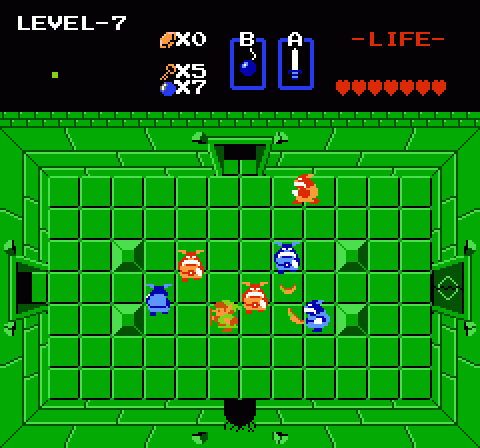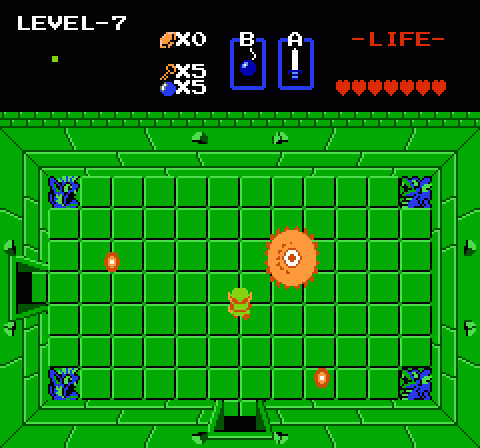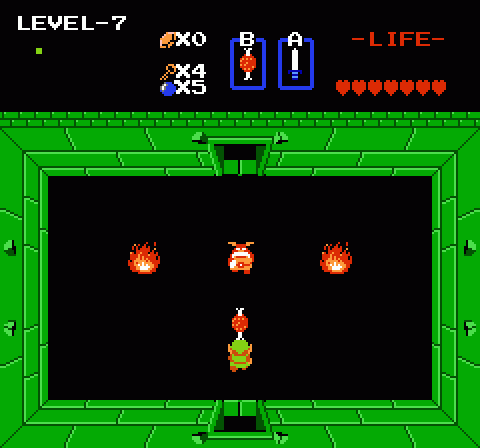I would like to put forth two possibilities for the design of The Legend of Zelda Level-07, Demon. Either it is meant to be a sorbet of sorts — a palate-cleanser — in the wake of two extraordinarily difficult dungeons, or else someone got their numeration wrong and this was supposed to come much earlier in the game. Demon is one of the easiest dungeons in the game in terms of pure combat logistics; for the most part, it’s more on par with the third dungeon than the sixth. The most difficult mob that appears here is the Blue Goriya, and by and large the bestiary hearkens back more to the second and third levels. No Darknuts. No Vires. No Pols Voice. No Wizzrobes, thank god.

But! Zelda dungeons are not simply a matter of combat. Demon may play out less challengingly in terms of physical threats, especially if you sufficiently armed yourself for Level-06, but there’s more to the game than just killing things. There are two significant factors that make the idea that Level-07 was supposed to come earlier in the game downright fallacious.
First, it’s crammed with repeat bosses. You face off against two rooms full of triple Dodongos, a couple of Lanmola minibosses, and no less than three Digdogger chambers, two of which split into three parts when you play the Flute. Granted, none of these are as nasty as Level-06’s three-headed Gleeok (not even when you have gargoyles pelting you with fire as you battle three Digdogger nuclei), but the fact that half a dozen of the rooms here contain boss-calibre opponents marks a massive increase in the number of heavy hitters to appear in a single stage.

More importantly, though, this dungeon is much more puzzle-like than any we’ve seen to date. Progression through the stage requires liberal wall-bombing to smash open sealed passages, and even armed with a Bomb Bag you’re likely to find yourself running short on explosives. The game kind of front-loads them by offering them as room prizes for several chambers early in the stage, but they’re harder to come by once you clear out the first Dodongo room (for which of course you need bombs); the toughest part of this stage for me was resource management, and I had to duck out briefly to find more bombs before I could reach the final boss area — which, incidentally, requires you to bomb a passage through a chamber that shows up on the map as not being part of the dungeon. The compass and map are easy to come by in this level, and probably not by coincidence. The compass is there to taunt you with the boss location, and the map is there to make you throw you off the actual route to the boss. It’s pretty clever.

Meanwhile, once you get through the “invisible” room, the hidden passage to the boss’ lair appears in a room with a moving block in a configuration that’s never appeared before and doesn’t intuitively communicate itself as such. Furthermore, even though that room appears empty but for a Bubble, you can’t push the moving block right away, because it’s locked away behind several Wall Masters that lurk invisibly out of sight and which you might not even be aware of. Even the dungeon itself is the best-hidden in the game. Granted, it’s a piece of cake compared to dungeon puzzles in modern Zelda games, but you have to give it credit for upping the chin-strokey ante in the original game.

Oh, and it also contains one of the game’s most infuriatingly enigmatic puzzles, too: A non-hostile Moblin, indestructible, who states “GRUMBLE, GRUMBLE” when you enter his lair. I’m sure you probably know the solution by now — feed him the otherwise almost entirely worthless Food item — but back in 1987 that was a heck of a head-scratcher.

Now, once you actually sort out these mysteries, stock up on Bombs, and find your way to the end, Level-07 is pretty easy. The final boss is another Aquamentis, which is no more difficult than the first. A measly two hits from the Magical Sword will do him in. But the trick is in figuring out how to reach him in the first place. I think for gamers well-versed in the ways of this game, Demon seems head-scratchingly simple, but the idea here was to warm players up for some of the more arcane level design challenges ahead. Future dungeons will combine both hard-hitting enemies and tricky layouts, but Level-07 represents the game changing gears.
Strangely enough, this was one of my favorite dungeons.
Aside from the navigation, the bait barrier, and finding the dungeon in the first place, Level 7 is a breeze, though there’s a lot of work to do to even get there.
To get in the front door you need the recorder, which you need the ladder to get, which you need the raft to get to the dungeon holding it. Even sequence breaking, you have to visit no less than three dungeons to get there. And that’s not even counting finding a shop to buy bait for the arbitrary NPC barrier inside.
Of course the reward for all this is the Magic Candle, which would’ve been nice to have much earlier in the game. Like, seven dungeons ago. Would’ve sped up all that tree arson for secret goodies and unwanted door fines a bunch.
Oh well, it’s worth it to two-shot Aquamentus with magic laser swords.
When I was a kid I didn’t know where all the heart pieces were. So I’d skip Level 6 and do Level 7 so I’d have enough hearts to get the Magic Sword. Thus tackling one of the hardest dungeons with the best sword. In fact, everyone I knew at the time did Level 7 first!
@Adam - THAT MAKES SO MUCH SENSE. I’ve been living my life all wrong.
I always liked Level 7. I agree partly with the idea that it’s a palate-cleanser, but I also think it’s meant to encourage players to sequence break. I know that sounds crazy compared to modern Zelda games, but once you know how the game works, clearing out 7 early, at least to get to the Red Candle, makes a lot of sense. In fact, I regularly try to grab the Red Candle and the Lion Key as soon as possible, though I always feel compelled to still wait to beat the bosses in order. Gamer habits are weird.
Yeah I always did/do 7 first. It solves a lot of problems in the long run.
also, Goriya-not Moblin.
-original Kishi
Course, the other point that makes it clear that 7 was meant to come after 6 is that all the dungeon maps fit together like puzzle pieces. But yeah, definitely lighter on the combat and heavier on the “puzzles”.
I’m pretty sure the phrase “you will be confronted by a hungry Goriya” appeared somewhere in the manual (or maybe the map, or SOME form of documentation that came with the game). But yeah there is no indication whatsoever that “GRUMBLE, GRUMBLE” means “Feed me”; I’ve seen it retranslated as “My stomach grumbles” in the fan translations of BS-Zelda, but from what I’ve read in the original Japanese it really is the equivalent of somebody muttering under his breath, not any kind of reference to a grumbling stomach. Go figure.